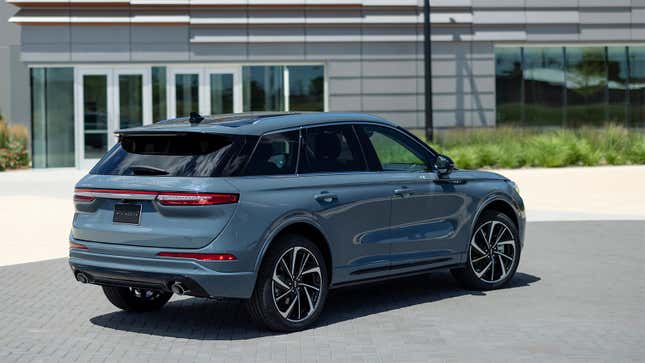These Are the Ford, Jeep and Chrysler EVs That Will Still See Tax Credits in 2023

There are still a few Ford, Chrysler and Jeep models that come with federal EV tax credits, everyone in Washington is talking about free-trade deals and one battery manufacturer is beating Tesla to the race it started. All that and more in this edition of The Morning Shift for Thursday, April 6, 2023.
New York Joins California, Banning Non-Electric Vehicles After 2035
1st Gear: Ford and Stellantis EVs Still Get a Break
The Inflation Reduction Act’s new battery sourcing rules take effect April 18. The vast majority of electrified and battery-electric models are going to see their $7,500 credits slashed by half, if not removed entirely. Here’s what that looks like for Ford and Stellantis’ range, per Reuters:
Out of six Ford vehicles, just the F-150 Lightning pickup truck and Lincoln Aviator Grand Touring will still be eligible for a $7,500 credit. The other models currently getting credits – Ford Mustang Mach-E, Ford E-Transit, Ford Escape Plug-In Hybrid and Lincoln Corsair Grand Touring – will see credits drop to $3,750.
Stellantis said of its three plug-in hybrid electric models, its Chrysler Pacifica plug-in electric hybrid will qualify for $7,500 tax credits after April 18, while the Jeep Grand Cherokee 4xe and Jeep Wrangler 4xe qualify for just $3,750.
“We will make sure our products are able to use those subsidies,” Stellantis CEO Carlos Tavares told reporters on the sidelines of the New York Auto Show adding the credits are a “major driver for the industry because it impacts the affordability.”
That’s honestly not as bad as it seemed from the jump, when some experts predicted virtually no vehicles would qualify for the updated terms. Though of course, the percentage of battery materials that need to be derived from free-trade partners to qualify are scheduled to increase in the coming years. This gives manufacturers a little time to gradually establish a battery supply chain that cuts out China — that’s the whole purpose of the law, anyway — though it also means that year to year, these subsidies are going to constantly be in flux.
2nd Gear: Trade Deals
For the IRA’s EV credit scheme to work, automakers need to prioritize domestic manufacturing over Chinese firms, where most of the battery supply chain is based. Of course, it’s literally impossible for that to happen overnight — despite the never-ending objections of certain opponents — which is why free-trade agreements are critical to ease the transition and give carmakers any incentive at all to avoid China.
G/O Media may get a commission
HEALTHIER HAIR
Augustinus Bader Hair Revitalizing Complex
Improve your hair today
The Hair Revitalizing Complex was tested via double blind trial to compare those taking it to those on a placebo. Those on the supplement were found to have increased their hair count by 56%, hair shine by 100%, and a 98% reduction in hair damage when compared to those taking the placebo. If these are the results you’re looking for, you can get a one-month supply (30 days) for just $130.
The mineral-focused deal the U.S. and Japan signed last week is one such example. At least, as far as the Treasury is concerned. It’s the very meaning of what constitutes a “free-trade agreement” that’s got everyone up in arms now. U.S. Trade Representative Katherine Tai recently offered some background on why her department is favoring more targeted policy these days, per Reuters:
In a policy speech at American University’s Washington College of Law, Tai said she is starting to change minds in Washington and in other capitals that the traditional approach of cutting tariffs no longer works in the highly competitive global economy of the 21st century.
“We are writing a new story on trade, one that makes us more resilient, our economy more sustainable, and our results more inclusive,” Tai said.
Trade needs to work hand-in-hand with industrial policy, Tai said, which the U.S. is employing to invest in infrastructure, semiconductors and clean energy technology. These incentives are resulting in good paying jobs, including for those without a college degree, Tai said.
She said past trade deals focused on “aggressive liberalization and tariff elimination” made the U.S. and other countries too dependent on China for critical materials. They also allowed Beijing to use state-led non-market practices to dominate key global industries, she added.
The Biden administration’s approach must address China’s “economic mercantilism” by making strategic investments at home to better compete and “strengthening our cooperation with like-minded economies to forge a fairer and more sustainable future for our people,” Tai added.
In other words, you can expect to hear about plenty more carveouts for battery production in certain countries going forward, and plenty more objections every single time the Biden administration goes over Congress’ head to sign one.
3rd Gear: Ford Takes Aim at Complexity
Perhaps if Ford’s cars were less complicated, it wouldn’t have to issue sweeping recalls every few weeks. It might also be able to make a little more money on every sale. Dearborn says that a focus on more simplified architectures should set into motion beginning with 2024 model-year vehicles, per Reuters:
Ford Motor Co plans “dramatic reductions” in the complexity of its product lineup starting in the 2024 model year, Jim Baumbick, the automaker’s product development chief, said Wednesday at a conference hosted by Bank of America.
At the same time, Ford plans to develop more variations of certain model lines, such as the Bronco SUV, because they offer 30% or greater profit margins compared to the base model, Baumbick said.
Ford Chief Executive Jim Farley has said the automaker’s product lineup and vehicle architectures are too complex and too costly. Ford is driving to cut billions from operating costs after 2022 profits fell short of investor expectations.
Baumbick also expressed a desire to bolster Maverick production capacity. That’s the only way Ford is really going to make more money on the compact truck, considering the relatively slim margins available given its entry-level price.
4th Gear: Silicon Anodes
Silicon-based anodes are one of those next-generation battery technologies that holds a lot of promise for EV efficiency. Sila, a Silicon Valley-based company, says its product has been tested and will begin making its way into automotive cells next year, with Mercedes’ EQG SUV. From Bloomberg, via Automotive News:
Sila, a Silicon Valley-based battery materials company with more than $930 million in funding, says it has finalized a mass manufacturing process for the first silicon-based anodes.
The company is calling its new material “Titan Silicon,” CEO Gene Berdichevsky said in an interview, and it’s in the later stages of qualification with automakers before a new factory begins production late next year.
Sila says Titan anodes will immediately boost maximum vehicle ranges by 20 percent.
Its first customer is Mercedes, which will use Titan anodes in its long-range EQG SUV, the electric version of the automaker’s boxy G-Class, starting in early 2025.
A concept model has been spotted testing in the Arctic ahead of the off-roader’s debut next year.
Berdichevsky says that Sila will be able to make enough material for up to 200,000 EVs a year by 2026 — and enough for a million vehicles a year by 2028.
“We are ready to take on more automakers now,” Berdichevsky said. “There are three things that customers care about, and it’s range, range, and range. We are here, and we are ready for it.”
Sila was actually started by a former Tesla engineer, and Tesla has been talking up silicon-anode batteries since at least 2020. Tesla wouldn’t be Tesla if it announced something when it was ready to build it.
5th Gear: E-Fuels for the 1 Percent
By now you’ve likely heard that Germany successfully delayed approval of the European Union’s 2035 internal-combustion engine ban over a stipulation to allow engines that run on e-fuels. But a new story from Bloomberg puts into perspective the sheer pointlessness of holding up everything to save the future of synthetic fuel, an energy source that will be completely irrelevant to all but the wealthiest individuals:
Analysts doubt that the synthetic fuels will ever make a meaningful contribution to the industry achieving carbon neutrality. Only 2% of the EU car fleet can fully run on e-fuels in 2035, the lobby group Transport & Environment said in October, citing industry forecasts. Many argue the scarce supply of e-fuels that are years away would be better put to use by sectors that can’t transition to battery power as easily, such as aviation and shipping.
One of the biggest inhibitors is cost. E-fuels are made using renewable electricity to split hydrogen from water and combining it with carbon, an inefficient and expensive process. Synthetic diesel costs between $3.50 and $7 a liter to produce, according to BloombergNEF estimates — about four to seven times the price of traditional diesel in the European wholesale market.
Even after years of scaling up production, e-fuels for passenger cars probably will remain around four times more expensive than fossil-fuel gasoline, while improvements in battery technologies will make EVs more affordable and enhance their performance, LMC Automotive’s Al Bedwell wrote in a blog post last month.
Gerrit Marx, the CEO of Italian truck and bus maker Iveco, last week called the technology “the champagne of propulsion” that makes sense only for a small group of wealthy individuals who’d like to hang on to their combustion luxury and performance cars.
“If you have a Ferrari or if you drive your Porsche Turbo once a weekend, you’re not going to care whether a liter costs €5 or €8, but that’s not a fuel for the future,” Marx said in an interview.
So, rich people were the only ones that particularly cared about this. But you can’t excuse national pride as a contributing factor, too:
The German government’s behavior underscores the disruptive nature of Europe’s bid to become carbon-neutral by mid-century. The country’s auto industry spent decades perfecting the production of crankshafts, diesel injectors and other components not needed for electric motors, and is now under pressure to retool products and factories with potentially devastating effects to employment. Volkswagen, Mercedes-Benz, BMW and Porsche have started the transition, but remain well behind Tesla in EV sales.
I know we as car enthusiasts appreciate the idea of these kinds of cars running well into the EV era, but there’s something remarkably selfish and immature about obstructing necessary, critical measures to combat climate change over whether the finance minister of Germany’s Free Democratic Party can still drive his 911 in 20 years.
Reverse: The Great War
On this day in 1917 — 106 years ago — the House of Representatives voted 373 to 50 to declare war against Germany, and the United States formally entered World War I.
U.S. Enters WWI
Two days after the U.S. Senate voted 82 to 6 to declare war against Germany, the U.S. House of…
Read more
During 1917 and 1918, the Indianapolis Motor Speedway, which had opened eight years earlier, ceased motorsport activity and functioned as a military aviation repair and refueling depot.
Neutral: That’s a Lincoln!?

Image: Ford
I was today years old when I learned Lincoln sells a plug-in hybrid Corsair. Apparently, the brand can’t make enough of the things. I think Lincoln should co-opt Buick’s old ad campaign to make sure everyone knows about it.



